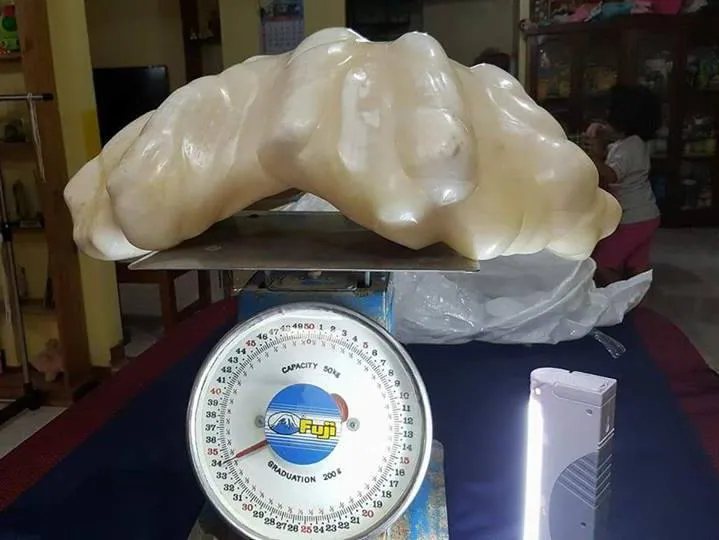At 75 Pounds, This Could Be the World’s Largest Pearl
The Filipino fisherman found the massive gem over a decade ago and kept it as a good luck charm
/https://tf-cmsv2-smithsonianmag-media.s3.amazonaws.com/filer/74/99/74999852-2878-40a1-84aa-84eb23be65fc/giant_pearl.jpg)
Yesterday, mollusk mania took hold of the internet when reports surfaced of a massive pearl discovered in the Philippines. The 75-pound pearl was reportedly discovered by a fisherman about a decade ago when his anchor accidentally snagged a giant clam, G. Clay Whittaker reports for Popular Science. When he reeled it in, he was surprised to find a pearl nearly as big as the clam itself and kept it for years as a good luck charm.
While the pearl’s size may be stunning, the process that made it is more or less the same as the tiny ones worn on a string. When an object like a grain of sand gets stuck inside a mollusk’s shell, it can irritate the soft-bodied animal, which prompts it to start forming layers of calcium carbonate around the annoyance, according to Ellen Strong, a research zoologist at the Smithsonian Museum of Natural History.
“It’s a natural process,” Strong tells Smithsonian.com. “The process of making a pearl is the outcome of making its shell.”
Though pearls are rarely found in clams, in theory it’s possible for nearly any shelled mollusk to make a pearl. All of these creatures harvest calcium carbonate from the water around them, which they use to form their hard, protective shells. Making a pearl is similar to creating the shell, but the layers of calcium carbonate encapsulate a foreign object instead of the mollusk’s own body.

“It’s like getting a splinter,” Strong says. “You don’t want to leave it in there. But unlike us, they don’t have opposable thumbs to help them pull it out.”
The pearl-making process isn’t just used to give the mollusk some relief from an abrasive object poking it in the soft parts—it can help fend off parasites as well. Mollusks are often the targets of parasites that bore into their shells in order to munch on the soft meat inside, but the same reaction that creates a pearl can also seal off these invaders and patch up the shell.
“It’s a defense mechanism like an immune response in humans,” Strong says. “It’s one of the options that it has to handle something that causes problems.”
The “Pearl of Puerto,” as local officials refer to the massive Philippine pearl, is certainly notable for its unusual size. While it still has to be confirmed by a gemologist, if it is a true pearl it could be the largest ever found, the BBC reports. By using x-rays to peer inside to its center, experts can count the gem’s growth rings, which are similar to those in a tree and can be used to estimate how long the giant clam worked to make this gigantic gem.
Pearls that are farmed, or cultured, grow to around a centemeter wide within a year, says Strong. Considering the size of the Pearl of Puerto, the giant clam had been worrying at it for quite some time.